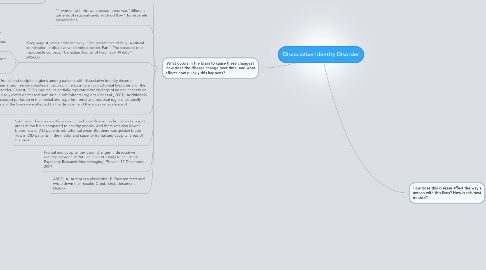
1. ** What occurs in the brain to cause these changes? How does the disease change over time, and what affects how quickly this happens? **
1.1. Vermetten, Eric, et al. "Hippocampal and amygdalar volumes in dissociative identity disorder." American Journal of Psychiatry 163.4 (2006): 630-636.
1.1.1. ABCD: A-Eric Vermetten, M.D., Ph.D.; Christian Schmahl, M.D.; Sanneke Lindner, M.Sc.; Richard J. Loewenstein, M.D.; J. Douglas Bremner, M.D. B-I cannot see any bias. They did scientific testing to get their results C-They are all doctors and psychologists. Their sources are cited. D-2006
1.1.1.1. People with certain stress related disorders such as PTSD, depression and multiple personality disorder, have been found to have a smaller hippocampal and people with multiple personality disorder have been found to also have smaller amygdala volume. Their hippocampal were 19.2% smaller than the average person and their amygadaldae were 31.6% smaller. Most everyone diagnosed is also diagnosed with PTSD.
1.1.2. Synthesis: People with did were put through tests and then the results were compared with the results from people without DID. It was discovered that people with DID have significantly smaller hippocampal and amygdalae. These results have also been found in people with PTSD, and depression. Many people diagnosed with DID are also diagnosed with PTSD.
1.2. 11 women with this were tested, there was "different patterns of regional cerebral blood flow " for separate personalities
1.3. Piper, August, and Harold Merskey. "The persistence of folly: A critical examination of dissociative identity disorder. Part I. The excesses of an improbable concept." Canadian Journal of Psychiatry 49 (2004): 592-600.
1.3.1. ABCD: A-August Piper MD, Harold Merskey DM B-slightly biased, believe what they say is true, but they do have evidence C- they are both doctors and their sources are cited. D-2004
1.3.1.1. The disease is not caused by childhood trauma, not enough tests or evidence
1.3.2. Synthesis: There is not enough evidence or tests to conclude that DID is caused by childhood trauma
1.4. "bilateral perfusion differences in frontal and occipital regions among patients with dissociative identity disorder compared with a group of non-traumatized healthy volunteers. Second, in relation to an orbitofrontal hypothesis for the etiology of dissociative identity disorder (Forrest, 2001), our results partially replicated the findings of an earlier study on dissociative identity disorder that also yielded decreased perfusion in orbitofrontal regions (Sar et al., 2001). Additionally, the present study documented increased perfusion in the medial and superior frontal and occipital regions bilaterally. Overall, anterior and posterior parts of the brain were affected by the disorder, and there was no evidence of lateralization."
1.5. Synthesis: There were differences in the blood flow in the frontal and occipital areas of the brain compared to healthy people. And there was also slower blood flow in DID patients orbitofrontal areas. But there was quicker blood flow in DID patients in the medial and superior frontal and occipital areas of the brain.
1.6. Frontal and occipital perfusion changes in dissociative identity disorder. Vedat Sar,Seher N. Unal,Erdinc Ozturk Psychiatry Research: Neuroimaging. Elsevier. 15 December 2007
1.7. ABCD: A- Author is a physiatrist . B-They ran tests and wrote down their results. C-published document D-2007
2. **What is the significance of each personality? What links each personality to the person?**
2.1. Howell, Elizabeth F. The Treatment of Dissociative Identity Disorder. Routledge, 2012.
2.1.1. ABCD: A- Elizabeth Howell B-she has worked with patients who have had DID for many years C-psychologist she has worked with patients who have had DID for many years D-2012
2.1.1.1. Personalities appear that contain memories the individual has blocked- personalities locked in time- both good and bad memories-there to protect the individual. Come out when needed, if person is afraid, brave personality will come out protect and comfort the person ect...
2.1.2. Synthesis: People create these alters to deal with painful events and memories. They can separate these traumatizing events into another entity thereby usually blocking the memory or event from the actual person. These alters can come out when the person needs them,. For example: when the person is frightened, a strong and brave alter may appear.
2.2. Piper, August, and Harold Merskey. "The persistence of folly: A critical examination of dissociative identity disorder. Part I. The excesses of an improbable concept." Canadian Journal of Psychiatry 49 (2004): 592-600.
2.2.1. ABCD: A-August Piper MD, Harold Merskey DM B-slightly biased, believe what they say is true, but they do have evidence C- they are both doctors and their sources are cited. D-2004
2.2.1.1. The disease is not caused by childhood trauma, not enough tests or evidence
2.3. alters used as coping method called dissociation
2.3.1. severe and reoccurring child hood trauma and or abuse
2.3.1.1. alters can have own personality, history, memories appearances, ages, genders, emotions, individual diosrders
2.3.1.1.1. some alters may be aware of eachother
2.3.1.2. can have false memories, that alter the actual person's perspective on the past
2.4. Alters in dissociative identity disorder: Metaphors or genuine entities? Merckelbach, Harald ; Devilly, Grant J. ; Rassin, Eric Clinical Psychology Review, 2002, Vol.22(4), pp.481-497 [Peer Reviewed Journal]
3. **How does this disease affect the way a person with this lives? How is this best treated?**
3.1. Howell, Elizabeth F. The Treatment of Dissociative Identity Disorder. Routledge, 2012.
3.1.1. ABCD: A- Elizabeth Howell B-she has worked with patients who have had DID for many years C-psychologist she has worked with patients who have had DID for many years D-2012
3.1.1.1. Many are often missed diagnosed, many are institutionalized. It can take five-twelve years to be properly diagnosed. Personality switches can be subtle or obvious. People with DID have amnesia or loss of large chunks of time, try and hide disorder because they think others will call them insane.
3.1.1.2. Treated by hypnosis, anti-depressants
